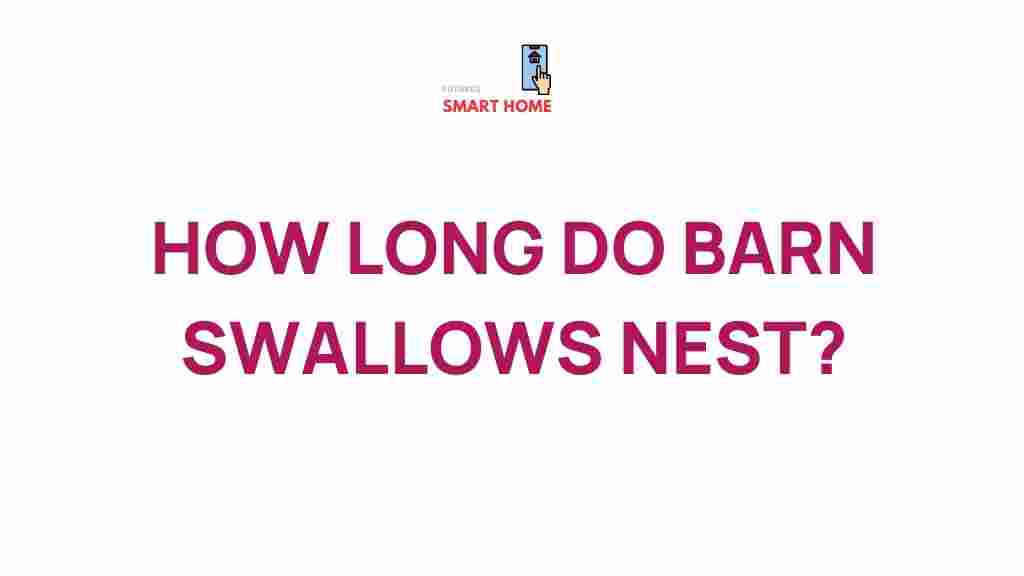Unveiling the Mysterious Nesting Habits of Barn Swallows
Barn swallows are fascinating avian species that have captivated birdwatchers and nature enthusiasts alike with their acrobatic flight and graceful presence. These small birds are known for their distinctive forked tails and iridescent blue feathers. One of the most intriguing aspects of barn swallows is their nesting habits, which showcase remarkable behavior and adaptability. In this article, we will explore the nesting habits of barn swallows, their behaviors, and the factors that influence their nesting choices.
The Nesting Process of Barn Swallows
The nesting habits of barn swallows involve several steps that reflect their unique adaptations to different environments. Understanding these steps is crucial for anyone interested in wildlife and avian behavior.
1. Choosing the Right Location
Barn swallows typically prefer to nest in sheltered areas that provide protection from predators and harsh weather. Common nesting sites include:
- Under eaves of buildings
- Inside barns and sheds
- On bridges and overpasses
- Near human habitation, where food sources are abundant
Their preference for nesting near human structures is largely due to the availability of mud, which they use to construct their nests. The presence of open spaces around these sites also allows for easy access to flying insects, their primary food source.
2. Building the Nest
The construction of a barn swallow nest is a collaborative effort that involves both the male and female. The process includes:
- Gathering materials: Barn swallows collect mud, grass, and feathers to create their nests.
- Shaping the nest: Using their beaks, they mold the mud into a cup shape, often building it against a wall or ceiling.
- Drying and reinforcing: The nest needs to dry to ensure it holds together, and swallows often return to add more materials as needed.
This meticulous building process highlights their ingenuity and resourcefulness, allowing them to thrive in various environments.
3. Egg Laying and Incubation
Once the nest is complete, the female barn swallow lays a clutch of typically 3 to 7 eggs. The eggs are usually pale blue or white and are incubated for about 12 to 17 days. During this time:
- The female primarily incubates the eggs.
- The male provides food for the female and protects the nesting area.
After hatching, the chicks are altricial, meaning they are dependent on their parents for food and care.
4. Raising the Young
After hatching, the parents are intensely dedicated to their young. The process of raising the chicks involves:
- Feeding: Both parents hunt for insects to feed their chicks, bringing back food multiple times a day.
- Keeping warm: The parents keep the chicks warm by brooding them, especially during cooler weather.
- Teaching flight: As the chicks grow, parents encourage them to leave the nest and learn to fly.
The commitment shown by barn swallows during this period is a testament to their parental instincts and social behavior.
Factors Influencing Nesting Success
Nesting success for barn swallows can be influenced by several environmental and behavioral factors:
- Weather conditions: Rain and cold temperatures can impact the availability of insects and the health of the chicks.
- Predation: Nest predators, such as cats or larger birds, can threaten the eggs and chicks.
- Human activity: While barn swallows thrive near human structures, disturbances from human activity can disrupt their nesting.
Understanding these factors is essential for anyone interested in protecting and observing these remarkable birds.
Common Nesting Challenges and Troubleshooting Tips
While barn swallows are generally resilient, they can face challenges during the nesting process. Here are some common issues and tips for addressing them:
1. Nest Damage
Natural elements or human interference can damage nests, leading to abandonment. If you find a damaged nest:
- Assess the damage: If it’s minor, the parents may continue to use the nest.
- Rebuild if necessary: If the nest is destroyed and the breeding season permits, consider rebuilding it using similar materials.
2. Predation
If you notice a high predation rate, consider:
- Implementing protective measures: Install barriers or use natural deterrents to keep predators away.
- Monitoring nests: Regularly check the nests to understand predation patterns and adjust your protection strategies.
3. Food Scarcity
In times of drought or environmental change, food sources may dwindle. To assist:
- Plant native flowering plants: This can attract insects, providing food for barn swallows.
- Avoid pesticide use: Chemicals can reduce insect populations that swallows rely on.
Conclusion
The nesting habits of barn swallows reflect their adaptability and resilience as a species. By observing their behaviors and understanding the challenges they face, we can appreciate the intricate dynamics of wildlife. Whether you are a birdwatcher, a nature lover, or simply curious about avian species, learning about barn swallows can deepen your connection to the natural world.
To help support barn swallow populations, consider creating a bird-friendly environment in your own backyard. For more tips on attracting wildlife, check out this comprehensive guide. Additionally, for more information on the behavior and conservation of barn swallows, visit the Cornell Lab of Ornithology.
By fostering a deeper understanding of barn swallows and their nesting habits, we contribute to the preservation of these incredible birds and the ecosystems they inhabit.
This article is in the category News and created by FutureSmarthome Team

1 thought on “Unveiling the Mysterious Nesting Habits of Barn Swallows”